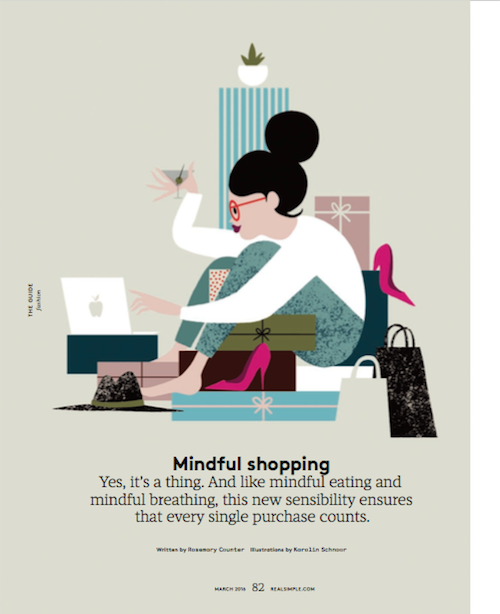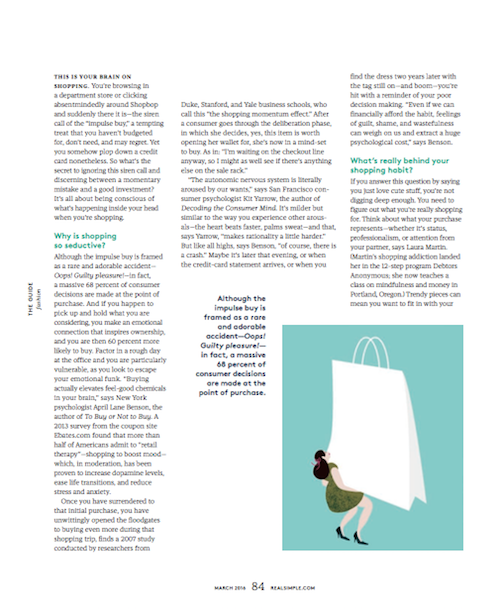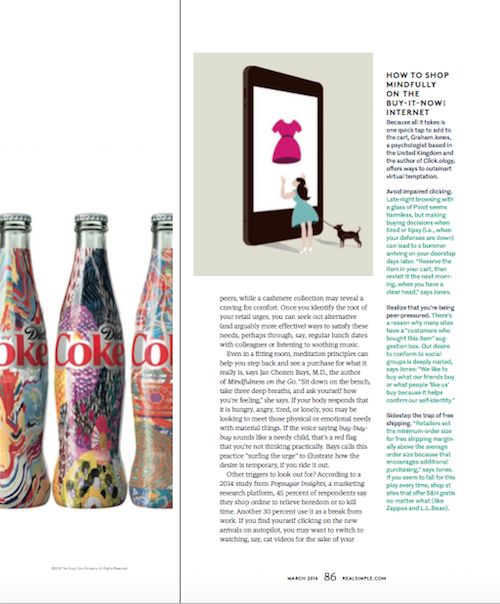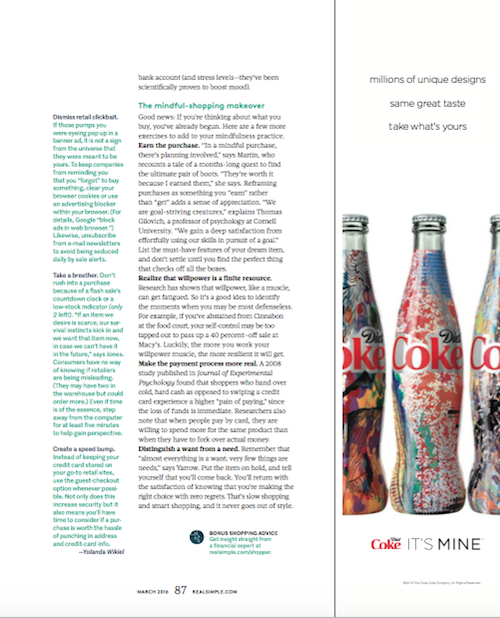Mindful shopping
Like mindful eating and mindful breathing, this new sensibility ensures that every single purchase counts
This is your brain on shopping: You’re browsing in a department store or clicking absentmindedly around Shopbop and suddenly there it is—the siren call of the “impulse buy,” a tempting treat that you haven’t budgeted for, don’t need, and may regret. Yet you somehow plop down a credit card nonetheless. So what’s the secret to ignoring this siren call and discerning between a momentary mistake and a good investment? It’s all about being conscious of what’s happening inside your head when you’re shopping.
Why is shopping so seductive?
Although the impulse buy is framed as a rare and adorable accident— Oops! Guilty pleasure!—in fact, a massive 68 percent of consumer decisions are made at the point of purchase. And if you happen to pick up and hold what you are considering, you make an emotional connection that inspires ownership, and you are then 60 percent more likely to buy. Factor in a rough day at the office and you are particularly vulnerable, as you look to escape your emotional funk. “Buying actually elevates feel-good chemicals in your brain,” says New York psychologist April Lane Benson, the author of To Buy or Not to Buy. A 2013 survey from the coupon site Ebates.com found that more than half of Americans admit to “retail therapy”—shopping to boost mood—which, in moderation, has been proven to increase dopamine levels, ease life transitions, and reduce stress and anxiety.
Once you have surrendered to that initial purchase, you have unwittingly opened the floodgates to buying even more during that shopping trip, finds a 2007 study conducted by researchers from
Duke, Stanford, and Yale business schools, who call this “the shopping momentum effect.” After a consumer goes through the deliberation phase, in which she decides, yes, this item is worth opening her wallet for, she’s now in a mind-set to buy. As in: “I’m waiting on the checkout line anyway, so I might as well see if there’s anything else on the sale rack.”
“The autonomic nervous system is literally aroused by our wants,” says San Francisco consumer psychologist Kit Yarrow, the author of Decoding the Consumer Mind. It’s milder but similar to the way you experience other arousals—the heart beats faster, palms sweat—and that, says Yarrow, “makes rationality a little harder.” But like all highs, says Benson, “of course, there is a crash.” Maybe it’s later that evening, or when the credit-card statement arrives, or when you find the dress two years later with the tag still on—and boom—you’re hit with a reminder of your poor decision making. “Even if we can financially afford the habit, feelings of guilt, shame, and wastefulness can weigh on us and extract a huge psychological cost,” says Benson.
What’s really behind your shopping habit?
If you answer this question by saying you just love cute stuff, you’re not digging deep enough. You need to figure out what you’re really shopping for. Think about what your purchase represents—whether it’s status, professionalism, or attention from your partner, says Laura Martin. (Martin’s shopping addiction landed her in the 12-step program Debtors Anonymous; she now teaches a class on mindfulness and money in Portland, Oregon.) Trendy pieces can mean you want to fit in with your peers, while a cashmere collection may reveal a craving for comfort. Once you identify the root of your retail urges, you can seek out alternative (and arguably more effective) ways to satisfy these needs, perhaps through, say, regular lunch dates with colleagues or listening to soothing music.
Even in a fitting room, meditation principles can help you step back and see a purchase for what it really is, says Jan Chozen Bays, M.D., the author of Mindfulness on the Go. “Sit down on the bench, take three deep breaths, and ask yourself how you’re feeling,” she says. If your body responds that it is hungry, angry, tired, or lonely, you may be looking to meet those physical or emotional needs with material things. If the voice saying buy-buy-buy sounds like a needy child, that’s a red flag that you’re not thinking practically. Bays calls this practice “surfing the urge” to illustrate how the desire is temporary, if you ride it out.
Other triggers to look out for? According to a 2014 study from Popsugar Insights, a marketing research platform, 45 percent of respondents say they shop online to relieve boredom or to kill time. Another 30 percent use it as a break from work. If you find yourself clicking on the new arrivals on autopilot, you may want to switch to watching, say, cat videos for the sake of your bank account (and stress levels—they’ve been scientifically proven to boost mood).
The mindful-shopping makeover
Good news: If you’re thinking about what you buy, you’ve already begun. Here are a few more exercises to add to your mindfulness practice.
Earn the purchase: “In a mindful purchase, there’s planning involved,” says Martin, who recounts a tale of a months-long quest to find the ultimate pair of boots. “They’re worth it because I earned them,” she says. Reframing purchases as something you “earn” rather than “get” adds a sense of appreciation. “We are goal-striving creatures,” explains Thomas Gilovich, a professor of psychology at Cornell University. “We gain a deep satisfaction from effortfully using our skills in pursuit of a goal.” List the must-have features of your dream item, and don’t settle until you find the perfect thing that checks off all the boxes.
Realize that willpower is a finite resource: Research has shown that willpower, like a muscle, can get fatigued. So it’s a good idea to identify the moments when you may be most defenseless. For example, if you’ve abstained from Cinnabon at the food court, your self-control may be too tapped out to pass up a 40 percent–off sale at Macy’s. Luckily, the more you work your willpower muscle, the more resilient it will get.
Make the payment process more real: A 2008 study published in Journal of Experimental Psychology found that shoppers who hand over cold, hard cash as opposed to swiping a credit card experience a higher “pain of paying,” since the loss of funds is immediate. Researchers also note that when people pay by card, they are willing to spend more for the same product than when they have to fork over actual money. Distinguish a want from a need. Remember that “almost everything is a want; very few things are needs,” says Yarrow. Put the item on hold, and tell yourself that you’ll come back. You’ll return with the satisfaction of knowing that you’re making the right choice with zero regrets. That’s slow shopping and smart shopping, and it never goes out of style.



